
|
|
Abstract: Five short reports about anti-war movements: "Australian Expo Raises the Banner of Peace," "Peace Takes a Holiday," "Beyond War: A New Way of Thinking," "Magic Peace Project," and letters. Notes: See also list of dialogue articles or image scans. |
Peace Notes
by Trudy Mesbah, Ruie Mullin, Joan Russ, et al.
published in dialogue, 1:2-2:1Los Angeles: 1986-1987
Australian Expo Raises the Banner of Peace
from dialogue 1:2, p. 29 (1986)
In the longest, largest and most successful proclamation event in Australian Bahá'í history, Bahá'ís staged a nine-day Peace Exposition at the House of Worship in Sydney that attracted thousands of people.
After the March 28-April 6 event was over, a summation of the well-publicized exposition reported "the Faith's emergence from obscurity in Australia has taken a giant step forward."
The Bahá'í Peace Exposition, staged to help observe the United Nations International Year of Peace, was the culmination of months of planning and received favourable comment and attention throughout Australia. Public information officers in individual Bahá'í communities used local media to heighten interest in the Expo.
The Expo itself featured a number of specialized conferences, including gatherings of Youth for Peace, Women for Peace and the Fifth Annual Bahá'í Studies Conference, each of which focused on some particular aspect of achieving lasting worldwide peace.
Speakers at those conferences were interviewed for local and national television. ABC Radio's religious department taped almost the entire Bahá'í Studies Conference as well as the Expo's peace conferences for use in future broadcasts.
Speakers from such prominent organizations as the Women's International League for Peace and Freedom, the Conflict Resolution Network and the Community Relations agency of New South Wales addressed various seminars.
"Non-Bahá'ís gained a respect for and awareness of the breadth and scope of the Bahá'í Faith and the importance of its teachings — particularly the message from the Universal House of Justice, The Promise of World Peace," the Expo's organizing committee reported. "The conference was a success in that it attained all that it set out to do in providing a program of top quality speakers from within and outside the Faith."
The titles of the speeches give some idea of the diversity of topics: "World Peace: Impossible or Inevitable?," "Creating a Non-Violent Society," "The Four Faces of Peace," "On Human Nature, Aggressiveness and War," and "The Planetization of Mankind."
Perhaps the most remarkable event was neither a particular talk nor a presentation, but the display of 10,000 hand-made peace banners sent from all parts of Australia and around the world for the Peace Expo. A smaller, similar ribbon encircled the Pentagon in Washington, D.C. last year and provided Bahá'í organizer Viva Rodwell with the inspiration for the ribbon, symbolic of world peace and unity. The brightly colored banners were draped throughout the Temple, used to decorate the marquees listing Expo activities and festooned on a stage erected on the front lawn of the Temple.
There were so many banners that thousands of them were tied end-to-end and strung up to form a "Peace Ribbon" stretching more than three miles from the Temple grounds to the shores of the Pacific Ocean. "It looked marvellous, stretching down the main road, around parks and the golf club til it reached the sand dunes," one conference participant wrote. "Even then, it didn't stop, for banners bedecked the walkway right to the beach with its breaking surf."
The banners became a major news story in the Australian press following incidents of vandalism. No sooner were the banners in place than over 300 were either burnt, effaced or stolen.
A Bahá'í spokesperson commented that the banners had been given to the Bahá'ís "in trust and now the immense work done by children, monasteries and churches around the world has been destroyed." Volunteer teams came to the aid of the Peace Expo, protecting the banners from further harm, while students of Mona Vale Primary School repaired damaged banners.
Bahá'ís and non-Bahá'ís who attended the Expo were impressed by the approaches to peace suggested by various speakers during their talks and a number of new contacts were made between Bahá'ís and like-minded members of the public.
But perhaps the most moving tribute to the Expo came from Melinda Hyde, a 9-year-old girl living in a suburb not far from the Bahá'í House of Worship. In a letter to the adults who organized and attended the Peace Exposition, Melinda wrote how the atomic arms race jeopardizes mankind with nuclear annihilation.
"If you are grown up, try and take part in stopping it," Melinda wrote. "I can't, because I'm only nine years old but I know what everything is about. When I grow up, I will certainly help all I can in honour of the Bahá'í Peace Expo, where I saw banners from Australia and all over the world, tied end to end to form a peace ribbon stretching from the Temple to the sea at Mont Vale, where I live."
Peace Notes
from dialogue 1:3, pp. 40-42 (1986)
PEACE TAKES A HOLIDAY
Zachery Berk had a vision. He saw an entire city celebrating a holiday of peace. In this vision, the city would transform one of its traditional holidays, say, the Fourth of July, into a gigantic peace festival. Every year the peace festival would be such a tremendous and lively event that one could not even think about the holiday without thinking about peace.
It’s a lovely vision. And Zach is not the kind of man to let a good idea die from neglect. He is an ordinary citizen, holding no political office or important position. I hope he would not be embarrassed if I called him a man who lets deeds, not words, be his adornment. So it came about that he organized and publicized the First Annual Fourth of July Peace Festival in Madison, Wisconsin.
When the big day finally came he arrived early at the site of the festival and waited eagerly for people to start showing up. Only one person came. He might have consoled himself with the thought that at least he had given it a good try and then let the idea drop. Nope, not Zach. He sat down with his crowd of one and figured out how to make the next year’s Fourth of July Peace Festival better.
This year the Seventh Annual Fourth of July Peace Festival will attract thousands to a two-day outdoor/indoor event complete with bands, food, workshops, exhibits, a dance, an interfaith worship service, children’s games, and (if organizers follow tradition) a candlelight, boombox parade to the state capitol followed by a concert or singalong in the capitol rotunda. (The boombox parade was originated by another Madison luminary for April Fool’s Day. Candlelight seems to dignify the proceedings. The idea is to have marchers bring a bunch of boomboxes all tuned to one local station which agrees to broadcast the marching music, in this case a song about peace or world citizenship.)
In the past few years Bahá'ís have helped organize the festival, have held workshops, and have participated in the worship services. They’ve also manned an information table for the Faith each year. This year they were asked to organize the worship service. A few Bahá'ís in any community could initiate a peace festival by calling a planning meeting and inviting members of various peace groups to attend. If your city or town does not have many peace groups (Madison has over one hundred) churches and youth organizations are good sources of volunteers.
Probably you would not want to make this a “Bahá'í event” totally under the auspices of the Local Assembly. There will be many peace groups with political messages to convey which would not be appropriate for a Bahá'í event. The official Bahá'í involvement would be limited to booths, workshops, etc., sponsored or approved by an L.S.A. On their individual initiative Bahá'ís could perform a vital community service by organizing the event as long as they made it clear that they do not represent the entire Bahá'í community.
Such a festival not only helps wage peace, but it is also an instrument of social and spiritual development in the community. Holidays are part of a society’s image of itself. Think how our collective self image and our unity is enhanced by Christmas or by an ethnic festival. A peace festival, if it really does become a major community event, creates a more peaceful and unified society.
A peace festival may attract people for its music, new games for children or ethnic food stands. Once there, however, they can find out how to become more involved in peace work. They can attend workshops to become more informed on peace issues. They can be stimulated to consider the necessity of “resolving issues not customarily associated with the pursuit of peace,” as the Universal House of Justice put it. This is true particularly if Bahá'ís organize the workshops to ensure that the issues of racism, economic inequality, inequality of the sexes, etc., are represented and discussed.
Peace festivals achieve many of the same goals that conferences, talks, panel discussions and the like also achieve. They bring various peace groups together in a spirit of unity. They stimulate greater peace activism. They attract people to the Bahá'í Faith and position Bahá'ís in leadership roles in the peace movement.
But festivals are different from all other formats. They become part of the rhythm of the community. They become part of family tradition and are looked forward to year after year. They transform as well as inform. By having something for everyone they attract large numbers of people and they celebrate the diversity of the community. They are joyful. They are spiritual. They create peace and unity where other methods only create talk.
Zachery Berk wanted to change the way a community celebrates its holidays. By starting a peace festival he just may one day discover his city has a peace holiday.
- Trudy Mesbah
Stoughton, Wisconsin
At the outset of the nuclear era, Albert Einstein warned us that, “The unleashed power of the atom has changed everything save our modes of thinking and we thus drift toward unparalleled catastrophe.” The people involved in Beyond War—A New Way of Thinking are working to change our modes of thinking. They are setting about to change themselves and, in the process, to change us. To reach the heart of every man, woman and child with the knowledge that “all war is obsolete and that all life is interconnected, that people will rise to the challenge of A New Way of Thinking.”
Is it possible to change our way of thinking? Of course it is; it may take a little time, but nothing is impossible. Do you know of anyone who is looking forward to the total destruction of our world as we know it? Well then, take a good look at this new way of thinking, see if it doesn’t appeal to you, and if it does, take affirmative action.
At an orientation meeting given at one of the member’s home about 11 people, most of us strangers to each other, gathered hopefully to find a better understanding of nuclear proliferation, war as we have known it to be, and war as it would be the next time. A film was shown describing the wars of our history. It’s a terrible thing to watch how little we think of human life, how easy it is to kill. Young boys, 17 and 18, asked to give up their lives for a territorial line that is invisible to the naked eye, or for an ideology. Of course, we all believed that it was good to fight in WWII, Hitler and his ideals were twisted and maniacal but it isn’t possible to fight that kind of “conventional war” today. “Conventional war.” It sounds so logical doesn’t it? What is conventional about killing your fellow man.
After the film we split into groups and talked about what Einstein meant in his statement, how has nuclear power changed everything…save our modes of thinking? We discussed how our physical, social and psychological environments have been forever altered; how we are capable of completely destroying each other and our entire life support system. Yet, we don’t seem to be able to take that giant quantum leap with our minds, to resolve conflict without violence. Beyond War works to expand identification to the whole earth and all humanity so that we can begin to change our patterns of behavior.
Beyond War says there is a way out of the nuclear nightmare we find ourselves in. But it will take all of us working together; one person alone cannot make a difference, it takes everyone working in a grassroots movement, coming together with one priority, as one body.
In this short time, I cannot give it all to you. I cannot stress too emphatically, that time is working against us. If you feel the same way, and are interested in more information, please contact the offices listed below. We can make a difference.
For more information about BEYOND WAR:
| NATIONAL OFFICE 222 High Street Palo Alto, CA 94301 (415) 328-7756 N.W. REGIONAL OFFICE 7840 S.W. 34th Portland, Oregon 92719 (503) 246-3604 SOUTHERN CALIFORNIA OFFICE 110 S. Adams Glendale, CA 91205 (818) 241-4852 ROCKY MOUNTAIN REGIONAL OFFICE 1980 Dahlia Denver, CO 80220 (303) 399-5470 |
- Ruie Mullins
Burbank, California
A peace project called “The Magic Peace Project” launched in the Magic Valley of southern Idaho appears to have great possibilities as a long-range educational effort for promoting peace and building bridges of cooperation among diverse groups. The Magic Peace Project was conceived by the Magic Valley Committee for the International Year of Peace in an effort to promote world peace and education for world citizenship throughout Idaho. The project itself was developed through a process of community dialogue involving public officials, educators, religious leaders, youth, artists, and the general public. Incorporated into the project are a number of elements which allow for networking with a wide variety of groups.
According to Harry Massoth, the Bahá'í committee member and project director,
the long-range goal of the Magic Peace Project is to help make world peace by the year 2000 an idea whose time has come. The strategy we devised for accomplishing this goal is to spread the concept that by “thinking globally and working locally we can reach out across the land to unite the hearts of man.” The conceptual framework for the project is based on ideas drawn from a number of important documents including The Global 2000 Report to the President, Catholic and Protestant peace statements, the Bahá'í statement The Promise of World Peace, and the Beyond War brochure, “Beyond War: A New Way of Thinking.” Some thirteen different statements drawn from these documents make up a set of “foundation concepts” and are the key to building bridges of cooperation among many peace-oriented groups.The project really came alive, said Massoth, when a group of high school students invited singer-songwriters Lesli Spiro and Kelly Bruss to endorse the project.
When Lesli and Kelly accepted the invitation we were able to create a booklet outlining ten activities or “magic tricks” to promote peace with each “trick” being introduced with lyrics from Leslie and Kelly’s cassette “We Are One.” The activities include such things as the “magic” of proclamation, prayer, inspiration, positive vision, action, and celebration. In the “Magic of Celebration” we suggest that people begin planning now for a festive Celebration of Life to be held in the year 2000. This provides the project with a fifteen-year time frame.Other aspects of the project include a friendship card/peace pledge, a peace survey, and a “global village peace vote, balloon launch, and sing-a-thon,” each of which provide imaginative yet simple means of attracting attention and involving people.
Specific events coordinated by the peace committee include a “We Are the World Show,” observances of World Religion Day and Martin Luther King, Jr., Day, a peace and friendship rally, a series of classes on promoting peace offered through a local college, a series of news articles on pathways to peace, a workshop with Beyond War, Idaho’s first “global village conference,” and a Hands Around the Park event coupled with the “global village balloon launch.” In addition, the committee has secured two governors’ proclamations and four mayors’ proclamations for the IYP and made presentations to city councils, school districts, ministerial associations, and civic and service organizations.
According to Massoth, the Magic Peace Project can be easily adapted to most local circumstances and thus serves as a model peacemaking program.
- The Magic Peace Project
Buhl, Idaho
Letter to the editor, from dialogue, Vol. 2 No. 1, pp. 4-5 (1987)
GIVE PEACE A CHANCEThere are thousands of organizations in North America working for peace, and many of them are listed in the directories on the enclosed list.
Should not the Bahá'ís be prominent on these lists of organizations? I would like to respectfully suggest that National and local Spiritual Assemblies appoint permanent committees (that is, committees would be reappointed each year) to work for peace. The work of these committees could include presenting the Peace Message to groups and individuals, peace projects they initiate, and working in coalition with other peace organizations. The committee(s) names and addresses could then be submitted to the appropriate directories and the name Bahá'í would be available to groups all across North America for like-minded groups and individuals to contact.
In Illinois there is an organization called COPRED (Consortium on Peace Research, Education, and Development). They publish a newsletter bimonthly called the COPRED Peace Chronicle, have lists of books they publish on peace, and list publications by others on peace. So many materials, books and magazines are being done by Bahá'ís on peace, it would be wonderful to see them all listed in this newsletter. In addition, they have a calendar of events across the United States and the world that have to do with peace. Bahá'ís are doing these things all the time, giving classes, having conferences on this subject, and they could all be listed here! COPRED is associated with University of Illinois at Champaign-Urbana and the address is included on the enclosed list at the bottom. Directories
American Peace Directory. Ed. Melinda Fine and Peter Steven. Institute for Defense and Disarmament Studies. Lists more than 1,350 peace groups in the U.S. $12.95, 1984. (2001 Beacon Street, Brookline, MA 02146)
A Directory of Canadian Peace Organizations with International Concerns. Mennonite Central Committee, 1483 Pembina Highway, Winnipeg, Manitoba R3T 2C7, Canada
A Directory of Small Groups Seeking Peace. Compiled by Pax Dei and WorldPeacemakers. Small grassroots organizations concerned with war and peace, related social issues. 1984. (P.O. Box 444, Damascus, MD 20872)
The Disarmament Directory. Resource Center for Nonviolence and Harbinger Communications. $11.50. 1984.
Consortium on Peace Research, Education, and Development. University of Illinois at Urbana/Champaign, 911 West High Street, Room 100, Urbana, IL 61801 USA (217) 333-2069.
- Joan Russ
Portland, Oregon
"Australian Expo Raises the Banner of Peace," in dialogue 1:2, p. 29 (1986) |
 click for larger image |
"Peace Notes," in dialogue 1:3, pp. 40-42 (1986) |
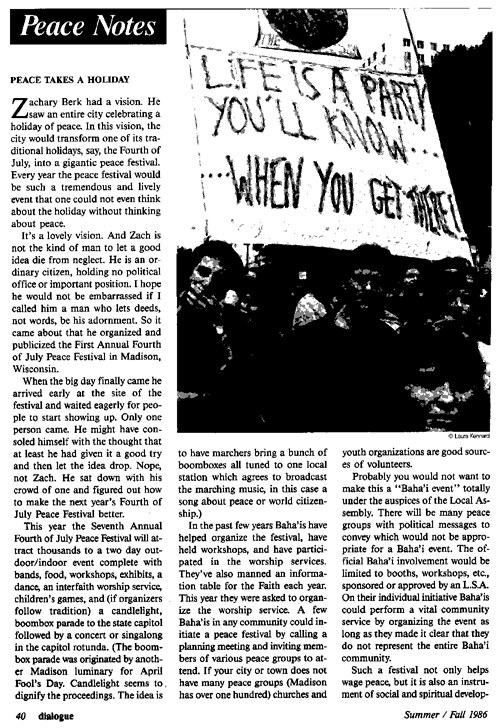 click for larger image |
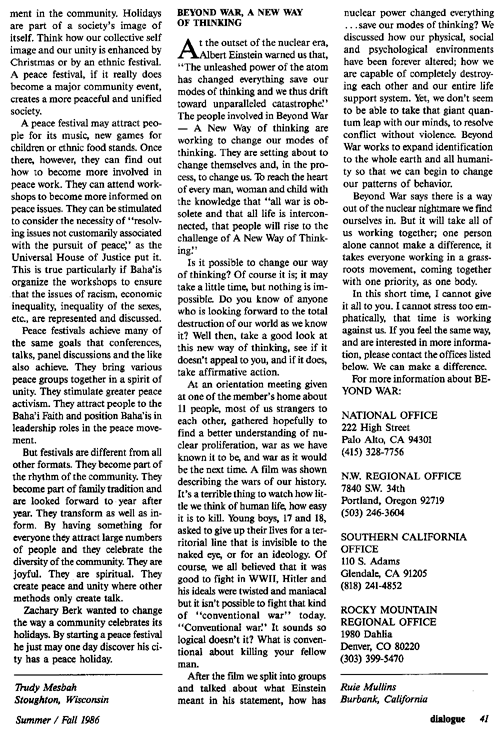 click for larger image |
 click for larger image |
| Response from Marilyn Higgins, published in dialogue 1:3 pp. 4-5 |
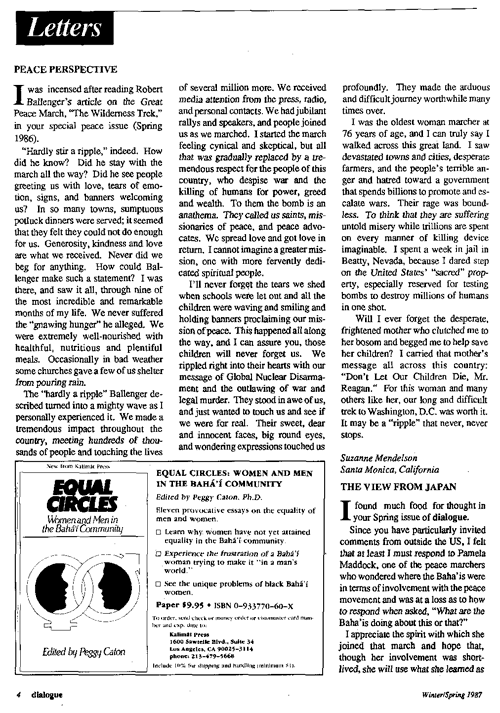 click for larger image |
 click for larger image |
| Letter to the editor from Joan Russ, published in dialogue 2:1 pp. 4-5 |
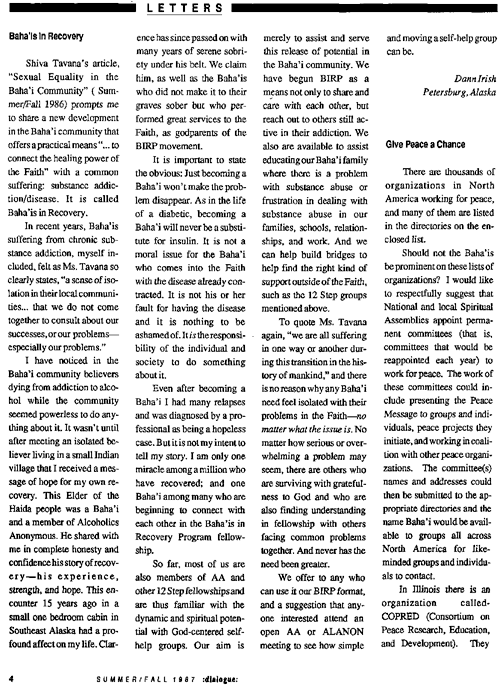 click for larger image |
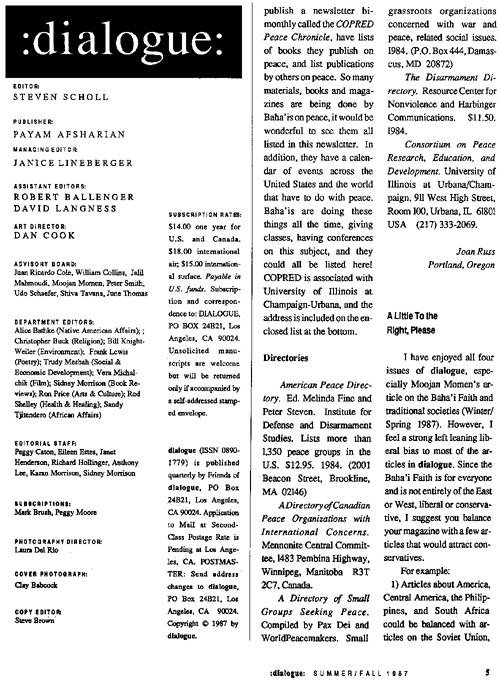 click for larger image |
|
|